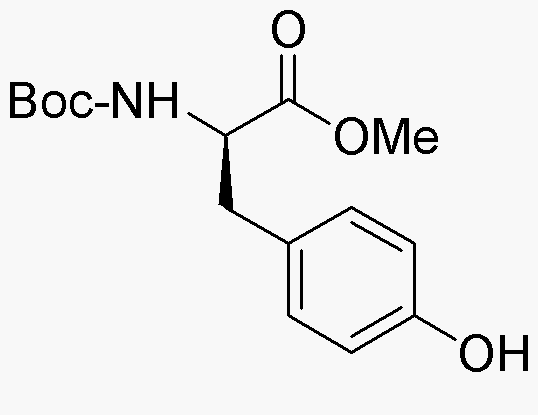Boc-D-tyrosine methyl ester is widely utilized in research focused on:
- Peptide Synthesis: This compound serves as a key building block in the synthesis of peptides, particularly those that require protected amino acids. Its protective Boc (tert-butyloxycarbonyl) group allows for selective reactions, enhancing the efficiency of peptide formation.
- Drug Development: In pharmaceutical research, it is used to create analogs of bioactive peptides, which can lead to the development of new therapeutic agents. Its ability to modify the structure of peptides can improve their efficacy and stability.
- Bioconjugation: The compound is employed in bioconjugation processes, where it can be linked to other molecules, such as drugs or imaging agents. This application is crucial in targeted drug delivery systems, enhancing the specificity of treatments.
- Research in Neuroscience: Given its relation to tyrosine, it is used in studies exploring neurotransmitter pathways and their implications in neurological disorders, providing insights that could lead to novel treatments.
- Cosmetic Formulations: Its derivatives are explored in cosmetic chemistry for their potential antioxidant properties, contributing to skin health and anti-aging products, appealing to the growing demand for effective skincare solutions.
General Information
Properties
Safety and Regulations
Applications
Boc-D-tyrosine methyl ester is widely utilized in research focused on:
- Peptide Synthesis: This compound serves as a key building block in the synthesis of peptides, particularly those that require protected amino acids. Its protective Boc (tert-butyloxycarbonyl) group allows for selective reactions, enhancing the efficiency of peptide formation.
- Drug Development: In pharmaceutical research, it is used to create analogs of bioactive peptides, which can lead to the development of new therapeutic agents. Its ability to modify the structure of peptides can improve their efficacy and stability.
- Bioconjugation: The compound is employed in bioconjugation processes, where it can be linked to other molecules, such as drugs or imaging agents. This application is crucial in targeted drug delivery systems, enhancing the specificity of treatments.
- Research in Neuroscience: Given its relation to tyrosine, it is used in studies exploring neurotransmitter pathways and their implications in neurological disorders, providing insights that could lead to novel treatments.
- Cosmetic Formulations: Its derivatives are explored in cosmetic chemistry for their potential antioxidant properties, contributing to skin health and anti-aging products, appealing to the growing demand for effective skincare solutions.
Documents
Safety Data Sheets (SDS)
The SDS provides comprehensive safety information on handling, storage, and disposal of the product.
Product Specification (PS)
The PS provides a comprehensive breakdown of the product’s properties, including chemical composition, physical state, purity, and storage requirements. It also details acceptable quality ranges and the product's intended applications.
Certificates of Analysis (COA)
Search for Certificates of Analysis (COA) by entering the products Lot Number. Lot and Batch Numbers can be found on a product’s label following the words ‘Lot’ or ‘Batch’.
*Catalog Number
*Lot Number
Certificates Of Origin (COO)
This COO confirms the country where the product was manufactured, and also details the materials and components used in it and whether it is derived from natural, synthetic, or other specific sources. This certificate may be required for customs, trade, and regulatory compliance.
*Catalog Number
*Lot Number
Safety Data Sheets (SDS)
The SDS provides comprehensive safety information on handling, storage, and disposal of the product.
DownloadProduct Specification (PS)
The PS provides a comprehensive breakdown of the product’s properties, including chemical composition, physical state, purity, and storage requirements. It also details acceptable quality ranges and the product's intended applications.
DownloadCertificates of Analysis (COA)
Search for Certificates of Analysis (COA) by entering the products Lot Number. Lot and Batch Numbers can be found on a product’s label following the words ‘Lot’ or ‘Batch’.
*Catalog Number
*Lot Number
Certificates Of Origin (COO)
This COO confirms the country where the product was manufactured, and also details the materials and components used in it and whether it is derived from natural, synthetic, or other specific sources. This certificate may be required for customs, trade, and regulatory compliance.


